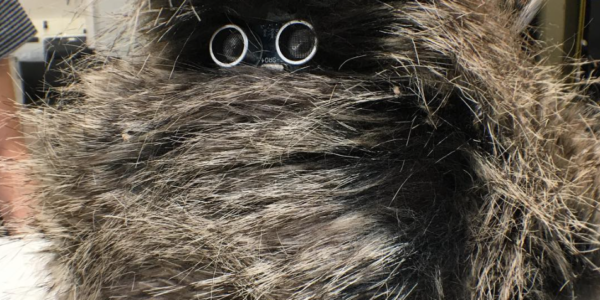Jan de Coster on sci-fi and robots

Jan De Coster grew up with a fascination for science and sci-fi stories, and soon made his first physical interactive installations.
In the early 2000s, while working at BBDO Jan De Coster developed a passion for characters. In 2012, another agency called him with the request to build them a robot. Four weeks later ‘Yummy the Robot’ was born ,and Jan became a robot-maker from then on, with a focus on exploring the boundaries of human-robot relations.
Robots Rachel and Robin travel all over the world, depending on people around them to take care of them, and Steve is a 2 meter tall, friendly giant who can charm every robot-scepticus. Meanwhile Jan also teaches about robots, encouraging creative people embrace robots as a genuine creative medium. We had the good fortune to meet Jan at this year’s Pictoplasma Conference & Festival in Berlin, as he spoke on stage about the notion of consciousness in a robot. Here, we sit down with the artist to delve deeper into his inspirations and creative process.
Can you tell our readers about your background and journey into visual art & character design?
In 1997 I started a webdesign studio in Antwerp, and after a few years my work moved to more interactive installations and interactive storytelling. I started working at BBDO in 2002 where I was making Flashgames. That is when I first heard about Pictoplasma. I went to the first festival in 2004 and I kept coming back every year. I developed a passion for characters although I wasn’t really creating them a lot outside my personal projects. Most of my work at BBDO was about physical interactive installations. Then in 2012 I got a call from an agency with a request for a robot.
At that moment my passion for character design and my expertise in physical installation collided and I became a robot maker.
Can you tell us anything about your early experiences of working with characters and robotics?
When I got the job for my first robot I only had 4 weeks to complete it. I had never made a robot before so it was a very bumpy ride 🙂 But after 4 weeks Yummy the robot came to life.
What has been your highlight / most significant moment of your career so far?
Of course the first robot was a very important moment, but also the creation of Steve, my largest robot yet, was a very important moment, because it showed me that a larger audience was ready for my robots.
Do you have any creative heroes? Who has had the most impact on your career and drive to specialise in robotics?
Of the last years I have seen a lot of amazing artists at conferences like Pictoplasma, so I would have to say that Peter and Lars have had a large impact on my by they way they curated the festival. The same goes for Héctor Ayuso from OFFF. And I owe a lot of gratitude to Joshua Davies for introducing me in the festivals circle.
Can you tell us about any reoccurring themes within your work? What fascinates you about human interaction with robots?
I am fascinated about the emotional connections people are willing to make with my robots, often after just a very short time.
I am fascinated about the emotional connections people are willing to make with my robots, often after just a very short time.
We understand you’re also a teacher , how does this role inform and inspire your professional work? Do you ever hire assistants / apprentices to learn about robotics for example?
I believe it is very important to show that robots can be a creative medium. That is why I first started teaching, but I also learned that sharing the experience of making a robot can be very inspiring. I run a course called Physical Interaction design and I teach the student how to make their first autonomous robot. Some of them end up making installations as their graduation project.You also presented a workshop for attendees to engage and get involved with – can you tell us about it?
I provided a bunch of materials and 2 basic formats for a simple robot life form. One is very simple and based on a miniature blender, the other is more advanced with 2 motors and a microcontroller controlling it’s movement. The idea is to imagine that the robot is crawling out of the sea for the first time, and trying to figure out how it should move on dry land.
How do you see your work evolving over the next few years? What do you think the future market for robotics might look like?
I will make larger robots, human size, that will be more visible when they interact with the world. I will also try to give them a place on our daily life so people can get used to them, and learn that they are really fun the be around, certainly nothing to be afraid of.
sulu.be/SlightlyOverdone | berlin.pictoplasma.com





